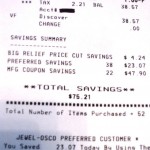Many of us spend hundreds of dollars a month on groceries and don’t even realize it. The other day in the grocery store, someone expressed his concern about the amount of money his family spent on groceries — they averaged $300 a week. That amounts to roughly $1,300 a month on food!
“You’ve gotta eat,” but what if you could save more money on your groceries?
Here are five ways to help you save money on your groceries:
- Create a grocery shopping list and stick with it in the store. Planning ahead helps you identify the items you really need. It also keeps you more organized, which should reduce your shopping time.
- Avoid impulse purchases. An impulse purchase is when you buy something that you did not intend to buy when you went into the store. Sound familiar?Research shows the longer you shop the more money you spend, that’s why planning ahead and using a shopping list helps you get in and out of the store quicker. I know those displays and the big on sale price can be a real draw, but do you really need that?
- Use coupons. If I expressed the value of a coupon as a math equation, it would be COUPON = FREE MONEY. 😀 Coupons really help you save money instantly on your purchases. Some of my favorite places to get coupons are:
- Newspaper – Sunday newspapers are usually filled with coupons. For additional savings, you may want to consider purchasing a newspaper subscription. Money saved using coupons regularly from the newspaper should more than pay for the subscription.
- Store – Some stores offer additional savings with their own coupons. You may find them on the store’s website, in weekly store ads or offered through their preferred card program. These coupons have the store’s name printed on them and do not say “manufacturer’s coupon”.In many cases, you can combine the store and manufacturer coupons for greater savings. For example, if you have a manufacturer’s coupon for $1.00 off a particular brand and a store coupon for $1.00 off that same brand of peanuts – then you can use both of them and receive $2.00 off your peanuts.
- Inside-the-Store – The best place to look for coupons in the store are the weekly store ads or deals paper. You may also find them in the blinkie coupon dispenser placed in grocery aisles, tear pads near an item or directly on the item you are purchasing.
- Internet – The internet is filled with a lot of coupons. Many stores, manufacturers and coupon specific websites offer printable internet coupons. A few sites to try are:
- CouponMom.com – offers grocery coupons and information on great deals at the grocery and drugstore on a weekly basis
- SmartSource.com & RedPlum.com – provides free printable grocery coupons
- Shop smarter.
- Shop local grocery stores on sales days (if applicable). Some stores offer special sales — Sunday through Wednesday or during holidays. Weekly ads inform you about sale days and any special offers.
- Check the expiration date of items before purchasing them.
- Bigger does not always mean the better value. Some stores show you the price/unit calculation, which is very helpful in determining the most value for your money.If your store does not provide this calculation, you can use your calculator to determine the cheapest option. You simply divide the price (e.g. $6.99) by the unit size (e.g. 100 oz.) and the lowest price per unit is the most value.
- Check to make sure the price you pay is right. Some stores give you the item free — when it rings up wrong.
- Stock up on sale priced items. If you see rock bottom prices on longer lasting items (e.g. cereal) it is a good idea to stock up and save.
Do you have any others ways you use to save money on your groceries? Please share them using the comments.




One piece of advice for the guys who get a grocery list from the wife, don’t go hungry!!! I can tell you a grocery list may cost you $100.00 can end up being $350.00 plus-plus being hungry. 2 cases of beer, 3 Big bag of chips, couple steaks, shrimps and frozen pizzas later will not only hurt the waist line also the wallet. Peace…… Don’t laugh it really happened!
You’re right, you are more likely to spend more money — when you go hungry. 😆 Kerlin, thanks for contributing this helpful tip to the blog!
Another thing you can do to save on money for clothing is shopping at the end of a season for the following year. For example you may need some black slacks for work, well when the summer items start arriving in the store the slacks will go on sale. One popular department store often have yellow dot sales, which means 75% off the original price especially at the end of a season. I usually only shop for sale items. If the item I would like is not on sale, I keep watching it until it goes down to what I am willing to pay. Even after the sale price if I can use a coupon with it, I will.
Perfect timing for this tip Carmelita! When it comes to shopping for clothing, the end of season sales are the best buys. Thanks for sharing your money saving tip on our blog. 🙂
Many us receive coupons each week and clip the ones for products we use. What do we do with the rest? A women’s church group came up with a solution. They asked members and friends to donate the unused ones. The group, who contributes to the local food pantry and a women’s shelter, is able to stretch their dollars further by using the coupons. Why not start up a group of your own. It could help your family and others. Diane
I agree I use the circulars to stock up on items that we buy and use routinely. My favorite items to buy this way are laundry detergents, toilet paper and paper towels. I look in multiple store circulars and find the lowest prices for the brands that I use. Then I stock up on that item.
Diane, your church group’s idea for contributing unused coupons to the local food pantry and women’s shelter is a great idea. Thanks for sharing it! For those who find free deals on items you do not eat, these may also be donated to the local food pantry.
Monica, it is great to see you contributing to our blog again. Thank you! Those are great items to stock up on. If you shop at warehouses like Costco, you may also find great deals and coupons to save more on those items. Just remember to shop value. 😉
I pity the fool who pays full price for groceries…..I pity the fool…:)
Purchasing items on sale is the best way to go. My wife and I like to shop for winter coats for our children in February and March to fit the next winter. Often name brand coats will be marked down 75% and you can purchase a high quality coat for as little as you would pay for a generic at Wal-mart. Shop smart and save money. Planning ahead is really a key to this equation.
Thanks for sharing your tips with us Jeremy! I totally agree, sometimes we automatically discount big name department stores as being too expensive, but in reality their markdowns are oftentimes lower prices than discount stores. And best of all, you pay less for a higher quality product. Now, that’s a Win/Win. 🙂